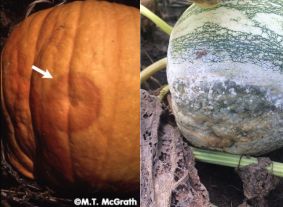Phytophthora Causes Squash Rot
Views: 372

Phytophthora Blight may be throwing a wrench into your pumpkin and winter squash crops as they enter the final weeks of the season. With squash crops and wet weather—and we’ve had some wet weather in New England this summer—comes the threat of fruit rot. Where there is water, there’s the possibility of a ruined crop.
Phytophthora Blight
The University of Massachusetts Extension Program shared a few of the possible squash rot culprits in a recent issue of their Vegetable Notes newsletter. The one that intrigued me the most was Phytophthora Blight. It probably caught my attention because I’ve seen it in my garden plenty of times. According to the piece from the UMass Veg Notes, this Blight starts off as a water-soaked spot. To visualize, picture for instance a blue cocktail napkin with a drop of liquid on it. That spot—a water-soaked spot—appears as a slightly darker color. The same is true of the Phytophthora Blight. This spot occurs at or near where the fruit meets the ground. That’s where the Phytophthora pathogen hangs out, after all, and the splashing of raindrops helps spread it to nearby fruit and foliage.
As the pathogen spreads across the fruit, the severity of the infection grows. It’ll begin to form a white mass of material in which its spores are produced. Eventually the entire squash and plant will be covered.
And if that wasn’t bad enough, Phytophthora can exist in the soil for years. Some climatic conditions will encourage its emergence and spread. Years that are wet and warm—with temperatures consistently between 80-90F—will have worse outbreaks than drier and cooler years.
What To Do About It
Phythophthora resistant varieties do not exist. Even so, there are ways to slow its appearance and spread, mostly dealing with managing soil moisture. Try to:
- Avoid overhead irrigation.
- Plant in well-draining locations.
- Use no-till gardening techniques to increase soil drainage.
Of course, there’s not much you can do about the “overhead watering” of actual rain. If you have a just a few vining squashes you could try trellising the plants so the grow upward instead of along the ground. This will help elevate both the leaves and fruit and away from splashing soil.
Read more about Phytophthora Blight from the helpful folks at the UMass Ag Extension Program in their Vegetable Notes newsletter.
Meet Ellen Wells
When you’re raised on a farm, you can’t help but know a thing or two about gardening. Ellen Wells is our expert on edible gardening.…







